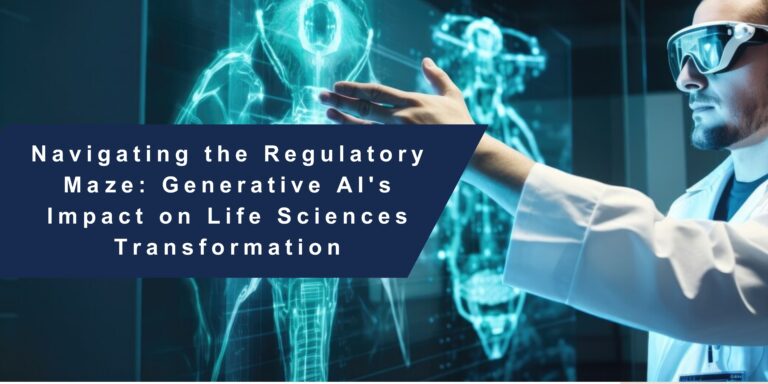In the realm of life sciences, artificial intelligence (AI) has long been a cornerstone, driving advancements in drug discovery, clinical trial optimization, and personalized patient care. However, a new player has entered the scene, ushering in a wave of innovation that is reshaping the regulatory landscape: Generative AI. While this technology holds the promise of transformative change, its integration requires a careful consideration of opportunities, compliance challenges, and risks associated with Good Practice (GxP).

Current AI Landscape in Life Sciences:
AI has already proven itself as an indispensable tool within the life sciences toolkit. Machine learning algorithms navigate vast datasets, uncovering patterns and predicting outcomes that elude traditional human analysis. Whether streamlining clinical trial recruitment or designing safer drugs, AI’s impact is undeniable.
Untapped Potential: AI Beyond Regulation:
Venturing beyond the confines of strict regulation, Generative AI presents exciting possibilities for non-regulated activities, such as:
- Generating Regulatory Intelligence: Picture AI scouring extensive regulatory landscapes, extracting key requirements, and even proposing compliance strategies—an invaluable asset for companies navigating the ever-evolving regulatory terrain.
- Automating Documentation: Bid farewell to mountains of paperwork! Generative AI can autonomously generate reports, summaries, and labels, significantly reducing the time and resources invested in manual documentation.
- Simulating Clinical Trials: AI-powered simulations predict potential challenges and optimize trial design, effectively reducing costs and expediting drug development.
Compliance and GxP: Treading Carefully:
While the potential is enticing, regulatory hurdles cannot be overlooked. Integrating AI into regulated activities demands a cautious approach, considering:
- Data Transparency and Traceability: Generative AI models often function as black boxes, raising concerns about data integrity and the explainability of AI-driven decisions.
- Validation and Verification: Regulatory bodies will insist on rigorous validation and verification of AI models before granting approval for their deployment in critical processes.
- GxP Compliance: Integrating AI into existing Quality Management Systems (QMS) and ensuring adherence to GxP guidelines is crucial to sidestep regulatory pitfalls.
A Risk-Reward Balancing Act:
Implementing Generative AI in life sciences necessitates a thorough GxP risk assessment. Early identification of potential risks—such as data bias, model instability, and system security vulnerabilities—enables proactive mitigation strategies.
Embrace Change with Caution:
The emergence of Generative AI in life sciences offers a unique opportunity. Its potential to streamline processes, enhance compliance, and accelerate drug development is undeniable. By approaching this technology with a keen eye for regulatory compliance and GxP risk management, life sciences companies can unlock its transformative power, ushering in a new era of regulatory efficiency and scientific advancement.
As the technology matures and the regulatory landscape evolves, the conversation will undoubtedly persist. Let’s embrace this transformative wave, navigate its complexities wisely, and collaboratively unlock the immense potential of AI for a healthier future. Contact us today to explore the power of Generative AI for a healthier future!

